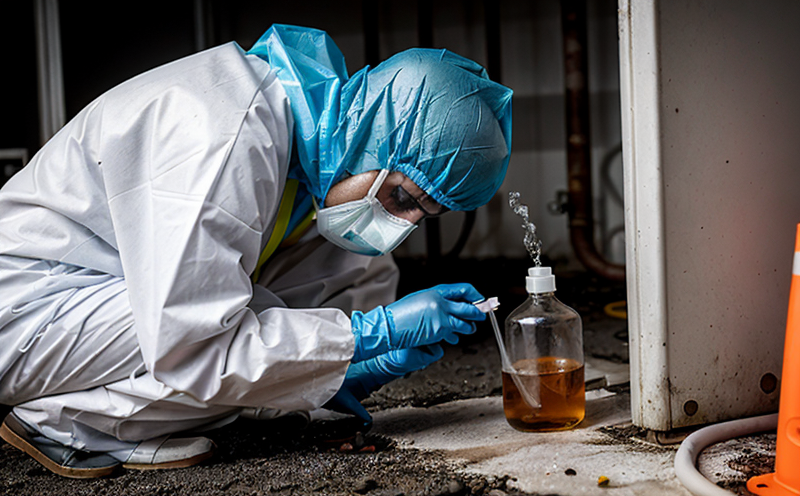Chemical & Contamination Testing
In additive manufacturing (AM) and 3D printing processes, ensuring product integrity is paramount. Chemical and contamination testing plays a critical role in identifying potential hazards associated with materials used in AM processes. This section focuses on the specific testing methodologies employed to ensure the safety of products manufactured using these advanced techniques.
The primary goal of chemical and contamination testing in additive manufacturing is to guarantee that the final product does not contain harmful substances, thereby protecting consumers and ensuring compliance with regulatory standards. This process involves several stages: material selection, precursor analysis, intermediate phase monitoring, and post-processing checks. Each stage aims at reducing risks related to potential contaminants or hazardous chemicals.
Material selection typically begins before any printing occurs; here, the focus is on sourcing materials that are not only reliable but also free from harmful additives or impurities. Precursor analysis ensures that raw materials meet specified purity levels and do not contain elements that could compromise product safety. Intermediate phase monitoring involves continuous observation during various stages of the AM process to detect unwanted by-products formed due to reactions between different components.
Post-processing checks are equally important as they help verify whether post-treatment steps have effectively removed any residual contaminants or introduced new ones. These tests also assess whether surface finishes and coatings adhere strictly to intended specifications without introducing adverse effects on overall quality.
The testing procedures for chemical and contamination analysis in AM involve rigorous laboratory techniques designed specifically for this purpose. Common analytical tools include gas chromatography, mass spectrometry, Fourier transform infrared spectroscopy (FTIR), X-ray fluorescence (XRF) spectrometers among others. These instruments allow us to detect trace amounts of chemicals down to parts per billion (ppb) levels.
Once the test results are available, they form part of an extensive report detailing all relevant findings along with recommendations for improvement if necessary. Compliance officers and quality managers can use these reports to make informed decisions about product safety and regulatory compliance.
To ensure consistency in our testing methodologies across various projects, we adhere closely to internationally recognized standards such as ISO 17654-2 (Additive manufacturing – Quality management systems for metal powder bed fusion processes) and ASTM F42 (Standard practices for additive manufacturing of parts from plastic materials).
Applied Standards
The application of international standards like ISO 17654-2 and ASTM F42 provides a framework within which our testing activities are conducted. These guidelines emphasize the importance of controlling variables throughout each stage of the AM process to minimize risks associated with chemical contamination.
For instance, under ISO 17654-2, there is specific attention given towards managing heat sources during powder bed fusion processes. Proper control over these parameters helps prevent overheating which can lead to undesirable reactions between metal powders and subsequent formation of impurities in the final product.
In line with ASTM F42, our tests also ensure that all plastic materials used comply with specified mechanical properties, chemical stability, and biocompatibility requirements. This ensures that products derived from these processes meet not only functional needs but also safety criteria.
By adhering strictly to such recognized standards, we provide clients with confidence in the quality of their products while ensuring full compliance with relevant regulations governing AM technologies.
Customer Impact and Satisfaction
The emphasis on chemical and contamination testing in additive manufacturing significantly enhances customer satisfaction by delivering high-quality products that are safe for end-users. Our robust testing protocols help identify potential issues early in the development cycle, allowing manufacturers to address them proactively rather than reactively after production has commenced.
Regular feedback from our clients regarding product performance further reinforces our commitment to excellence. We actively seek input on areas where improvements can be made and incorporate those insights into ongoing research and development efforts.
In addition to enhancing customer satisfaction, rigorous testing also contributes positively towards brand reputation by demonstrating a company's dedication to maintaining strict quality control measures. This transparency fosters trust between manufacturers and their customers, leading to long-term partnerships based on reliability and dependability.
Ultimately, our approach to chemical and contamination testing ensures that products meet the highest standards of safety and performance expected in today’s marketplaces. By leveraging cutting-edge technologies and adhering meticulously to established guidelines, we strive to deliver exceptional value to every customer interaction.
Use Cases and Application Examples
The application of chemical and contamination testing is particularly crucial when dealing with critical components where even minor impurities could have significant consequences. For example:
- In aerospace applications, any trace amount of contaminants in structural parts like turbine blades can lead to catastrophic failures during flight.
- Medical devices require stringent levels of purity since even small amounts of harmful substances could pose severe health risks.
- Consumer electronics demand materials that are not only durable but also free from toxins that might leach out over time.
In each case, thorough chemical and contamination testing ensures that these products meet strict safety requirements before being introduced into the marketplace. This proactive approach helps protect both users and manufacturers alike while maintaining a high level of trustworthiness in our services.





